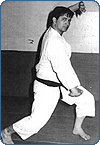Structure and development part 1
Structure and development of the Kenpo system, Part 1
The System of Ed Parker´s Kenpo Karate is considered to be one of the best documented and structured systems in the world. A System with geometry, mathematics, concepts, principles, and ideas with scientific elements. This will ensure the student will develop and work with the body and intellect in a maximal capacity.
In 1954 Ed Parker started the first commercial karate school in Pasadena, CA. USA. Karate was a virtually unknown word at that time. Mr Parker said that when he opened the school people came in thinking it was a Mexican restaurant. Today when one travels around the US you can see how different martial art systems use the word karate in there advertising even though they actually don’t teach karate. The reason being that now the word karate is a highly recognisable word.
In the mid 1960´s Mr Parker wanted to start spreading his self-defence system by franchising schools. When he tried to market his business idea he received the question, ”What do you have on paper?” Mr Parker realizing that nothing or not much was written down of the system, decided to create a training manual so the school owner would have the curriculum of the system.
What Mr Parker wanted was franchising like McDonalds, a restaurant in every city all over the world. All the Kenpo Schools would have manuals as guidance for every level and by doing so the student could be offered and assured the same product no matter were in the world the lived.
Mr Richard ”Huk” Planas started to train under Mr Tom Kelly and in the late1960´s Mr Planas met Mr Parker. Mr Planas stayed under Mr Parker and became one of his top instructors together with Mr Tom Kelly. Mr Planas tells the story that they spent many hours and days to finish the project of writing these manuals.
During the early 1960´s there were three different colours of belts used. The colours were white (four levels), brown (three levels) and black (ten levels). The white belt had brown tips, the brown belt had black tips and the black belt had red tips. The tips represented the colour you were working for. Red stood for mastery within the black belt.
Ed Parker was the founder of the International Karate Championships (IKC) which were consider one of the largest tournaments in the world in the 1960:s -70:s and -80:s. The tournament was held in Long Beach California. USA. In the patch for the IKC flame one can find the four belt colours mentioned above.
Around 1970 the first manual was released and it contained 32 techniques from orange to green belt. There are not many that have the original manual today. Ever since there have been new manuals on the market that have been changed periodically for questionable reasons. In 1981 the second version of the manual was released with 24 techniques. In 1985 there was another version released.
After Mr Parker’s passing in the end of 1990 many new organisations came into being and many have released their own manuals. I do not wish to comment on the manuals or if they have become better or worse, that is not to me to decide. It is all the of students and instructors own opinion to say if this has created a clear picture of the art or if it has created more headaches and confusion. Mr Parker stated, ”Knowledge of what is useful or useless only comes from time, experience and logic.”
To receive his brown belt he would learn the extensions from the orange belt techniques which were called the green-orange. After this, the student learned long form 4, 5 and 6 to reach his black belt as the extensions for the other belts were not completed yet.
Some potential students who were unsure of making the commitment to a long term contract brought about the yellow belt course also called the basic belts course. This course consisted of mostly basics and ten self-defence techniques. In 1971 the yellow belt became part of the system. What is interesting is when you look at the basic sheet on these manuals you will find that yellow and orange had the same basics. This is another proof that the yellow belt was put in later in the original system structure of Kenpo.
One of the things that many don’t know is that the system was influenced by many people. For instance the kicking set taught now was not created by Mr Parker but by Mr Tom Kelly; who also created the stance set. The staff set was created by Mr Chuck Sullivan. As your knowledge grows and understanding the rules and principles of motion you should see that some techniques were not created by Mr Parker.
Ingmar Johansson
Athletics consultant
5:th degree black belt
Head instructor for Ed Parker´s Kenpo Karate in Sweden.



